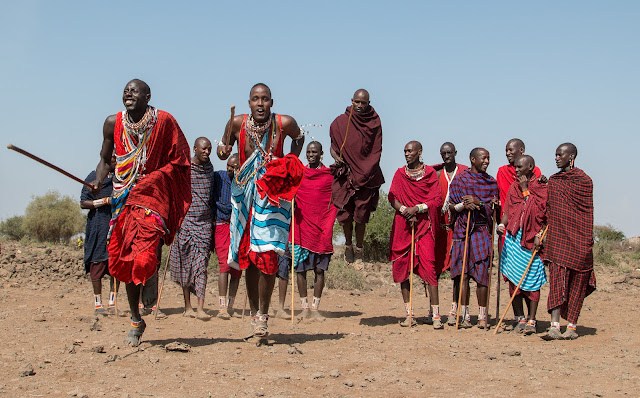After this morning’s drive we carried on to visit a Masai
village. Quite a few miles out we met these ladies who were out
collecting firewood.
Then two other ladies were by the track side and asked junior for a lift, apparently they were walking between villages to visit someone and had left at 7:00 – it was now about 11:00 and the sun was blisteringly hot. They were very grateful for the lift and each of them took off one of their many necklaces and gave them to us. Embarrassingly all we had to give back were some BA toothbrushes and mini toothpaste packs – not sure they knew what they were but they sat clutching them for the remaining 15 min drive.
We were met at the village entrance by the village chief’s son, Olayselanga sic who was fairly tall compared to most Masai we’d seen to date and been well educated at a school 60 odd miles away. I think he was the village's Sales and Marketing Manager.
I’d just assumed we’d wander around and in 10 minutes have seen the whole place. But as we stood by the truck out from the village came Masai after Masai, both male and female, and proceeding to give us the traditional welcome of chanting, dancing and finally jumping. It was just amazing.
Look at the guy at the back, he must be 3' in the air.
The village is set in a round to provide protection and 4 families live in each quarter. Polygamy is still the norm for their culture and with 6 wives allowed for each male quite a few houses are needed.
We were then introduced to the son of the main medicine man, who is following in his father’s footsteps.
He described how various different plants were used as natural remedies, all of which seemed to involve a lot of boiling either in water or milk, drinking the resulting infusion and then vomiting a lot!! There was also a stick which is given to pregnant women at 6 months which is supposed to shrink the baby and another which is a natural form of Viagra – I just hope the two never get mixed up.
Three Masai then showed us how to light a fire purely by friction. It seemed to take an age but eventually we had a flame and they were mightily pleased.
I do wonder though why they don't ensure there is always a fire burning somewhere in camp as it would save an awful lot of effort!
It is the women’s job to build the houses and each “wife” has her own house consisting of two bedrooms, one for the children and one for the adults. There are no mattresses, just a dried buffalo hide to sleep on and a fire in the corner. They are made of mud with straw roofs and last about 10 years, inside the rooms are divided by a rush screen and it is pitch black inside – we had to be guided step by step and it was ages before our eyes accustomed to the darkness.
As always the children are beyond cute. I'm sure they get a lot of foreign visitors but they still seemed very interested in us and keen to engage.
Although clearly the little girl on the left was less than pleased to see us.
Look at the expression on the girl in the middle's face - wise beyond her young years.
Having paid our US$20 entrance fee each, Olayselanga sic was adamant we could photograph who we liked but, although I repeatedly asked him for confirmation, I'm not entirely convinced this old lady was very happy about it.
After that we were invited to look at some of their wares which were laid out nearby. It was quite daunting, I think just about every village member had their own little “stall” and we had to walk along each one, shaking hands and exchanging names. Graeme had already warned us that the prices were rather high and if we wanted anything to bargain hard but also that if we didn’t buy no one would be offended. It was really difficult as there was nothing I particularly liked and how do you choose which of the many (4 families, 6 wives each – 24 stalls) to buy from – so we politely declined explaining our luggage restrictions.








































